I tried to start the recap of the March Kenya trip with a day-by-day blow-by-blow, but as you can see that didn't really work out. All the days have kinda blurred together at this point so I just know when things happened by other markers, like the weather, or what we were doing that day (chimps or safari), or who was visiting the research centre.
For a few days some Kenya Wildlife Service (KWS) vets were visiting, they had to knock down a lioness for treatment as well as sedate some elephants to repair their GPS collars. The visiting vets stay at the research centre and more than doubled our numbers while they were there. Matthew, the head vet, also had a lot to say about the black market animal trade and poachers. He was very vehement about them, and told us some pretty horrible stories about animals he had encountered with snares caught somewhere on their body which he then had to remove. George, the Ol Pejeta vet, also hates poachers, with a seemingly irrational passion. However, they basically oppose everything these wildlife vets do, so I guess it's not all that irrational.
The chimp sanctuary at Ol Pejeta is pretty spectacular. They have a 20 foot electric fence that serves both to keep chimps in and predators out. Inside the enclosure live warthogs, bushbuck, mongoose, all the birds that choose to go in and out, as well as all the small mammals that I am sure have no problem navigating the fences. I saw some little mammals but they were far away so I was unable to identify them, plus I didn't have a mammal ID book. Never fear, I've brought one this time.
The chimps live in two groups, and they seem pretty happy with their social lives. The smaller group is called "Young chimps" although they're not actually younger, just newer to the sanctuary (both groups came from a Jane Goodall Institute Sanctuary in Burundi when civil war broke out and it was no longer safe to keep the chimps there). Both of the night houses available to the chimps are really nice, although young group's night house has bars on the ceiling so hammocks can be hung from there. They really loved it, playing and rolling around when they came in for dinner.
In contrast, old group is much larger and their evening ritual is a bit more raucous. With 22 chimps to bring in, give dinner, and get into their sleeping groups, you can imagine the noise that is created. The big boys all like to let everyone know when they arrive and that makes everyone start pant-hooting again... in the concrete-walled night house, it echoes quite a bit. For breakfast and dinner all the chimps get fresh fruit and vegetables and a corn-meal paste called ugali. They love their ugali, and everyone got even more excited when the caregivers brought out the big plate of steaming ugali towards the end of dinner. (I think this is akin to asking children to eat all their vegetables first before getting their dessert.) One big male, Poco, was particularly excited for his ugali, but despised the corn he kept being given. His eyesight is not very good due to some clouding on his retina so each time a caregiver would walk over towards him with an ear of corn Poco would get very excited, I think he thought it was ugali. Then, when he had the corn in his hands and realised it wasn't ugali, it would throw it on the ground. Fortunately, the boy eating with him seemed to really like corn and devoured what Poco didn't eat.
After spending a few days with the chimps -- all day, from breakfast until bedtime -- we went back out to help Kim collect her data. Driving around with Kim is especially fun because of the opportunity to see so many cool things. One afternoon we saw some warthogs and jackals in what appeared to be an altercation, and as we drove up everyone scattered. It seemed that the warthogs had tried to steal the jackals' dinner, a dead Thomson's Gazelle, and one of the young warthogs was still holding a Tommy leg as he retreated! The presence of our car really made the warthogs back off and allowed the jackals to reclaim their meal. When we told George, the vet, and some of the chimp caregivers about this they hardly believed us, and wanted photo evidence to know that it was true. I suspect that meat is not a large part of the warthog diet but in the dry season, as when we were there, when grazing is scarce they might rely on scavenging a bit more than they would otherwise.
We also got to see the above hyena den a few times. There were at least three youngesters and the same red-headed female watching them each time we visited. On our third visit we saw a few other hyenas walking up and got to see the youngsters greet the newcomer. The newcomer must not have been very high ranking as the red-headed female didn't even bother to get up to greet him. She just touched his nose when he came up and stayed in her den.
By far the coolest thing we saw was not when we were out driving with Kim, but when we followed the Italian documentarian one night as he and a ranger radiotracked the lions. As we were going past the Northern White Rhino enclosure we encountered a female cheetah with four cubs, all devouring a Tommy. The cubs were adorable, all growly and ravenous, and one of them kept overeating and having to go to the side and burp/vomit a little (I don't know if cheetahs can actually burp). We stayed there for about forty minutes watching them, and Blair kindly lent me her 70-300 lens to take some close up photos with. We were really lucky to see these guys, and the mother was lucky that no other big cats came up to scavenge. I have been told that other cheetahs, but especially lions, will kill cheetah cubs as an easy meal when scavenging their kills. Kim and Blair kept an eye on this female after I left and now she only has two cubs left, a pretty common outcome for female cheetahs, but if she keeps those two alive until adulthood she will have done a great job.
I also got to go on a pretty incredible flight with Capt. Peter Lempatu, a bush pilot staying at Ol Pejeta. He works for the Kenya Rangeland Trust (I could be totally wrong about that), and took each of us at the research center up in his two-seater plane for a quick trip. The flight was incredible, although I didn't think it was quite as cool as Kim did -- she was ecstatic and couldn't stop talking about flying for days. We got to see the entirety of Ol Pejeta from the air which was super awesome, flying the entire perimeter. I was pretty surprised how well we could see animals from the air, they weren't little brown smudges as I had expected, but pretty easy to distinguish from one another. We flew right up until sunset, and as we pulled in to the landing we buzzed Kim, Brenda, and Blair, who were having a sundowner (drinks and watching the sun set) at the end of the airstrip.
It was April Fools' day as well, so when Kim, Brenda, and Blair were late to dinner Peter and I decided to play a little trick on them. We hid their food in the oven and other places in the kitchen and got the cooks to go along with our plan. When Kim, Blair, and Brenda, came back we were already eating and claimed that we thought they were having nyamachoma (barbecue) on their sundowner, despite the obvious absurdity of this. Brenda and Blair caught on pretty quickly -- the oven has a clear door and Blair's dinner used to be kept warm in there when she knew she was coming back late -- but Kim insisted on figuring out what was going on and it was hilaaaaaaaaarious. It really was awesome. Then we gave them their food and we all ate.
No more for now, I finished this from Dubai, although originally it was finished in the SF airport.
For a few days some Kenya Wildlife Service (KWS) vets were visiting, they had to knock down a lioness for treatment as well as sedate some elephants to repair their GPS collars. The visiting vets stay at the research centre and more than doubled our numbers while they were there. Matthew, the head vet, also had a lot to say about the black market animal trade and poachers. He was very vehement about them, and told us some pretty horrible stories about animals he had encountered with snares caught somewhere on their body which he then had to remove. George, the Ol Pejeta vet, also hates poachers, with a seemingly irrational passion. However, they basically oppose everything these wildlife vets do, so I guess it's not all that irrational.
The chimp sanctuary at Ol Pejeta is pretty spectacular. They have a 20 foot electric fence that serves both to keep chimps in and predators out. Inside the enclosure live warthogs, bushbuck, mongoose, all the birds that choose to go in and out, as well as all the small mammals that I am sure have no problem navigating the fences. I saw some little mammals but they were far away so I was unable to identify them, plus I didn't have a mammal ID book. Never fear, I've brought one this time.
The chimps live in two groups, and they seem pretty happy with their social lives. The smaller group is called "Young chimps" although they're not actually younger, just newer to the sanctuary (both groups came from a Jane Goodall Institute Sanctuary in Burundi when civil war broke out and it was no longer safe to keep the chimps there). Both of the night houses available to the chimps are really nice, although young group's night house has bars on the ceiling so hammocks can be hung from there. They really loved it, playing and rolling around when they came in for dinner.
In contrast, old group is much larger and their evening ritual is a bit more raucous. With 22 chimps to bring in, give dinner, and get into their sleeping groups, you can imagine the noise that is created. The big boys all like to let everyone know when they arrive and that makes everyone start pant-hooting again... in the concrete-walled night house, it echoes quite a bit. For breakfast and dinner all the chimps get fresh fruit and vegetables and a corn-meal paste called ugali. They love their ugali, and everyone got even more excited when the caregivers brought out the big plate of steaming ugali towards the end of dinner. (I think this is akin to asking children to eat all their vegetables first before getting their dessert.) One big male, Poco, was particularly excited for his ugali, but despised the corn he kept being given. His eyesight is not very good due to some clouding on his retina so each time a caregiver would walk over towards him with an ear of corn Poco would get very excited, I think he thought it was ugali. Then, when he had the corn in his hands and realised it wasn't ugali, it would throw it on the ground. Fortunately, the boy eating with him seemed to really like corn and devoured what Poco didn't eat.
After spending a few days with the chimps -- all day, from breakfast until bedtime -- we went back out to help Kim collect her data. Driving around with Kim is especially fun because of the opportunity to see so many cool things. One afternoon we saw some warthogs and jackals in what appeared to be an altercation, and as we drove up everyone scattered. It seemed that the warthogs had tried to steal the jackals' dinner, a dead Thomson's Gazelle, and one of the young warthogs was still holding a Tommy leg as he retreated! The presence of our car really made the warthogs back off and allowed the jackals to reclaim their meal. When we told George, the vet, and some of the chimp caregivers about this they hardly believed us, and wanted photo evidence to know that it was true. I suspect that meat is not a large part of the warthog diet but in the dry season, as when we were there, when grazing is scarce they might rely on scavenging a bit more than they would otherwise.
We also got to see the above hyena den a few times. There were at least three youngesters and the same red-headed female watching them each time we visited. On our third visit we saw a few other hyenas walking up and got to see the youngsters greet the newcomer. The newcomer must not have been very high ranking as the red-headed female didn't even bother to get up to greet him. She just touched his nose when he came up and stayed in her den.
By far the coolest thing we saw was not when we were out driving with Kim, but when we followed the Italian documentarian one night as he and a ranger radiotracked the lions. As we were going past the Northern White Rhino enclosure we encountered a female cheetah with four cubs, all devouring a Tommy. The cubs were adorable, all growly and ravenous, and one of them kept overeating and having to go to the side and burp/vomit a little (I don't know if cheetahs can actually burp). We stayed there for about forty minutes watching them, and Blair kindly lent me her 70-300 lens to take some close up photos with. We were really lucky to see these guys, and the mother was lucky that no other big cats came up to scavenge. I have been told that other cheetahs, but especially lions, will kill cheetah cubs as an easy meal when scavenging their kills. Kim and Blair kept an eye on this female after I left and now she only has two cubs left, a pretty common outcome for female cheetahs, but if she keeps those two alive until adulthood she will have done a great job.
I also got to go on a pretty incredible flight with Capt. Peter Lempatu, a bush pilot staying at Ol Pejeta. He works for the Kenya Rangeland Trust (I could be totally wrong about that), and took each of us at the research center up in his two-seater plane for a quick trip. The flight was incredible, although I didn't think it was quite as cool as Kim did -- she was ecstatic and couldn't stop talking about flying for days. We got to see the entirety of Ol Pejeta from the air which was super awesome, flying the entire perimeter. I was pretty surprised how well we could see animals from the air, they weren't little brown smudges as I had expected, but pretty easy to distinguish from one another. We flew right up until sunset, and as we pulled in to the landing we buzzed Kim, Brenda, and Blair, who were having a sundowner (drinks and watching the sun set) at the end of the airstrip.
It was April Fools' day as well, so when Kim, Brenda, and Blair were late to dinner Peter and I decided to play a little trick on them. We hid their food in the oven and other places in the kitchen and got the cooks to go along with our plan. When Kim, Blair, and Brenda, came back we were already eating and claimed that we thought they were having nyamachoma (barbecue) on their sundowner, despite the obvious absurdity of this. Brenda and Blair caught on pretty quickly -- the oven has a clear door and Blair's dinner used to be kept warm in there when she knew she was coming back late -- but Kim insisted on figuring out what was going on and it was hilaaaaaaaaarious. It really was awesome. Then we gave them their food and we all ate.
No more for now, I finished this from Dubai, although originally it was finished in the SF airport.
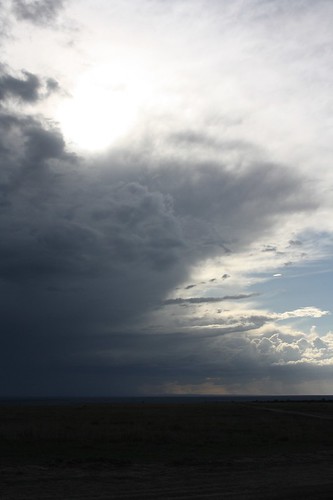
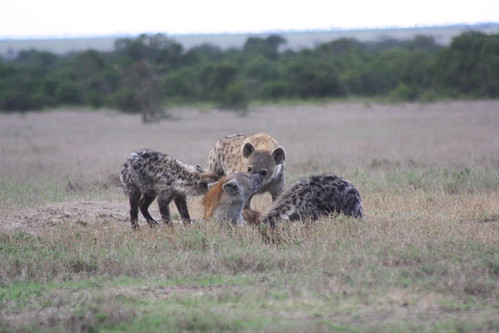
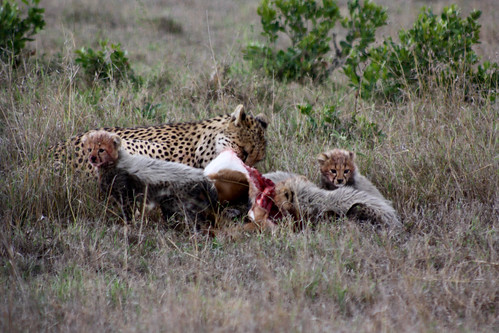

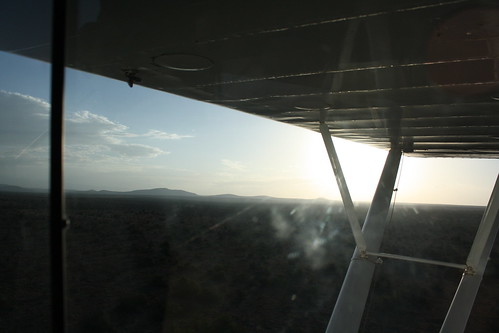
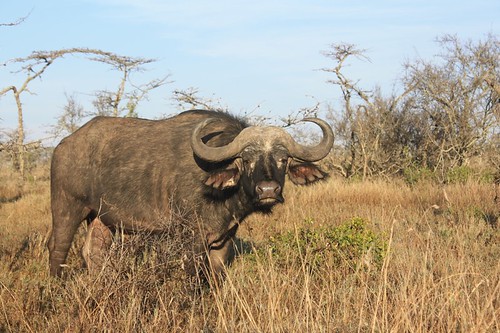
No comments:
Post a Comment